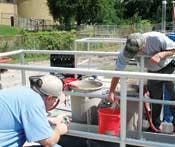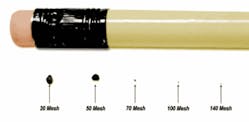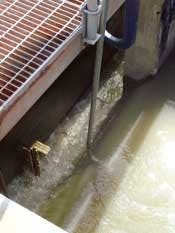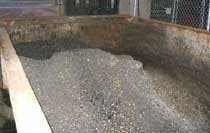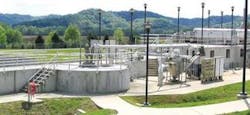by Frank Weis
One of the growing trends in the wastewater market concerns the emerging emphasis on grit removal system performance in plant headworks. The escalating application of membrane bioreactors (MBRs), specialized pumping equipment, and fine bubble diffusers in downstream plant infrastructure is driving investment in protective grit removal equipment.
A properly designed and operated grit removal system prevents grit buildup in unit processes, scouring and plugging in lines, and fouling of diffusers and membranes, while preserving the intended service life of the downstream equipment. In an age when funding sources are tighter and dollars are scarcer, protecting plant infrastructure is critical. As the stakes increase, it’s wise to take a closer look at the dynamics of grit removal – from a technical and business point of view – to achieve optimal outcomes.
Grit Dynamics
Because of the convolution of collection systems today and the type of materials that may be considered “grit,” the characteristics of grit removed from wastewater varies. Therefore, it’s important to define relevant terms and provide a brief overview of factors affecting how grit “behaves” in collected sewage.
• Grit consists of a variety of particles including sand, gravel, cinder, and other heavy, discrete inorganic materials found in domestic sewage. The Environmental Protection Agency’s Wastewater Technology Fact Sheet (Screening & Grit Removal), defines grit “as particles larger than 0.21 mm (.008 in.) (65 mesh) and with a specific gravity of greater than 2.65.”
• Specific gravity is the ratio of the density of a material to the density of water. If the density of water maintains a specific gravity value of 1, then objects with values greater than 1 are considered “heavier” than water and will – in time – settle. Therefore, specific gravity correlates to a particle’s settling velocity, which measures the speed or time a particle will settle in the water. This matters to grit removal systems that employ settling as the basis for operation. Settling velocities do not apply to forced vortex systems, which employ hydraulic means of removal.
• Mesh sizing is a common way to classify grit particle sizes, particularly for influent grit profiling and performance testing. Increasing mesh values translates into smaller grit particle diameters. Typical domestic sewage grit ranges from 20 to 140 mesh with the strong majority of grit (more than 90 percent) ranging between 50 and 100 mesh (the quantity will vary somewhat based on geographic location). Abrasive grit particles 100 mesh and larger create the greatest problems with downstream equipment. Particles smaller than 140 mesh begin to take on buoyant, silt-like characteristics, meaning they will rarely settle in a WWTP flow stream with any measure of velocity.
• Velocity plays a key role in grit travel through a collection system and WWTP flume. Ideal rates range between 2-3.5 ft./second (fps) in the flume leading to the inlet. At this rate, the flow will cause grit concentrations to travel like a moving bed along the bottom of the flume. At higher velocities, the flow becomes turbulent, dispersing the grit bed. When the overall velocity dips below 2 fps, grit will settle in the flume. Multiple straight currents exist within a flume, each with varying velocities. Grit will always be found where the lowest velocities of the flume occur. Basic physics demonstrates that the lowest velocities occur along the sides and bottom corners of an open flume because of friction, which slows the water. Therefore, grit will typically be found along the bottom corners of the flume. Understanding this is especially helpful for grit profiling and performance testing.
• Grit removal system performance is measured by removal efficiency. Removal efficiency is simply the percentage of grit continually removed from the influent. For example, high-performance grit removal systems achieve greater than 90 percent removal efficiency when properly designed and applied. Removal efficiencies can be attributed to individual particle sizes as well. However, the bottom-line is obtaining sufficient removal efficiency for all influent grit at normally encountered flows. Peak flow conditions caused by wet weather events bring more grit into the plant, which means systems must handle surges in flow and grit quantity.
The above terms provide important insight when designing a new grit removal system, evaluating an existing system, or performing a grit profile. Other standard factors for implementing enhanced grit removal include head loss, grit system sizing, maintenance, and energy-efficiency. Head losses through various grit removal devices can vary substantially, from as little as 0.25" to more than 12'. Be sure to review the effects of these differences, including requirements for higher heads. Likewise, examine the space requirements for your grit removal system and the corresponding capital costs, particularly with respect to excavation depth (if necessary) and the amount of concrete required. The same goes for on-going maintenance and energy-efficiency concerns.
Appraisal questions include: how will on-going operation and maintenance contribute to annual expenditures, and what are the energy demands for operating this system? Some grit removal devices require frequent cleaning while others may require periodic mechanical inspection and lubrication. Concerning energy use, some grit chambers may have no integral moving parts or power draw, but they may require power for ancillary pumping equipment used for head losses, velocity control, or continuous fluidizing.
Industry Overview
In 2008, more companies offer mechanized grit removal systems and services than ever before, underscoring the rising grit removal focus in the industry. Ironically, little differentiation exists between grit removal technologies – even among those from newer suppliers. Companies flooding the American market are supplying generic approaches with the immediate goal of qualifying for current bids rather than undertaking the significant financial and intellectual investment required for new product innovation.
Persuading decision-makers to specify novel approaches and unproven technology takes considerable time and resources to accomplish. Therefore, to get in the game now, some suppliers are choosing to capitalize on expired patents of leading grit removal technologies while other traditional headworks equipment suppliers are expanding their base offerings through equipment packaging.
Expired patents allow companies to replicate previously protected technologies. Examine these generic designs carefully. They may be represented as the same technology, but such companies can lack fundamental design knowledge, R&D, and the field experience afforded by the original innovator. Companies engaging in on-going R&D maintain an advantage over suppliers playing catch-up, particularly when bid prices are essentially equal.
For other suppliers, marketing strategy centers on packaging a variety of headworks equipment (screening, grit removal and grit handling devices) to improve bid success. Packaging is nothing new in the industry, but it historically occurred at the representative/distributor level. Now it’s originating at the manufacturing level, particularly as rampant industry consolidation continues. The key for end-users is evaluating the net results gained from selecting best available/best value technologies for each individual equipment segment verses an entire package that may include both premier and run of the mill equipment.
In today’s market, three types of grit removal systems dominate the landscape: vortex grit chambers (including forced hydraulic vortex and vortex settlers), centrifugal separators, and to a lesser degree, aerated grit chambers. Grit chambers and separators supply a basin or channel that reduces flow velocity, allowing inert grit particles to be hydraulically removed or settled out. Understanding the primary means by which grit chambers physically remove grit – hydraulic vs. settling – provides fundamental insight for system procurement and evaluation because the removal dynamics differ significantly.
Ironically, most self-described vortex and separator grit chambers rely on settling as the primary means of grit removal despite inducing some measure of centrifugal action, usually by way of cylindrical flow paths and/or rotating paddles. Sloped or cone-shaped chamber flooring is the key indicator of a primary settling device, the design of which depends on detention time and settling rates.
Meanwhile, vortex systems that integrate an inlet flume, flat-floor circular basin with a center opening, and flow baffles generate a hydraulically forced vortex to efficiently remove grit. Flat chamber flooring visually distinguishes a forced hydraulic vortex from a closely resembling settling device, but the velocities and the required detention time inside the chamber also remain different. Forced vortex systems incorporate rotating paddles, but the purpose is to separate organics from the grit particles, not creating a vortex. It’s important to note that settling rates do not apply at all to forced hydraulic vortex grit chambers.
Despite key process and removal differences, these systems often appear together as approved equals on bid lists for new projects. When this happens, consultants and end-users must sort out the differing prerequisites and operational nuances of each system type. By doing this, they champion contractor bids and reduce costly time delays and hassles during the equipment submittal and testing phases, not to mention receive a more robust system.
Grit Testing
Finally, the number of grit system testing services is growing. Companies like GritTech and Morris Testing Services exemplify companies providing comprehensive services. They help plants and consultants with both simple and complex grit analytics and performance testing. Aging plants requiring evaluations or grit profiling drive this sector growth, especially as numerous expansions or retrofits continue throughout North America.
Newly installed grit systems often require performance testing following start-up per the original project specifications. However, these specifications may be vague on the manner of testing. While specific performance-testing protocols have been practiced for decades, newly competing and less experienced service providers are breeding variations in testing methodology. This yields potentially inconsistent and inaccurate results. Currently, the research foundation arm of the Water Environment Federation is undertaking a significant review of grit testing methods to provide feedback for its member WWTPs and industry associates.
The following long-standing principles provide a reasonable basis for thorough testing and consistent protocol:
- Obtain grit samples from multiple points across the flume or channel, which is sometimes called cross-channel sampling. As highlighted earlier, grit does not “flow” like water. Because of its specific gravity, grit will be pushed by higher velocities toward lower velocity currents inside the flow stream. Water friction on the sides and bottoms of flumes reduce velocity; therefore, grit is typically located in the bottom side corners of the flume. Still, grit can be found in the center, so thorough influent testing should involve sampling from multiple points across the flume.
- Sampling equipment immersed in the flow stream should be narrow or slender – not bulky – so as to limit disruption of the flow velocity in the flume. Bulky collection devices will disrupt the flow velocity, which can potentially affect the grit collection.
- Label all collected samples by the time of day, collection location, and recorded channel velocity. Not only is it important to determine the distribution of the grit sample collection, it’s important to record exactly where grit occurs in a particular WWTP flow stream.
- Dry sieving vs. wet sieving – Dry-sieving grit samples entails burning raw samples in a muffle furnace in order to remove organic material in between the particles. Once dry and organic-free, the grit can be sieved in order to profile the actual size particles in the sample. This practice is the safest way to determine the grit profile, and has been historically practiced across the industry. Wet sieving is a less wide-scale approach that seeks to measure settling velocities rather than particle sizes. This approach requires a prolonged process because the capillary action between the fine screens, water and grit particle makes sieving difficult; therefore traditional sieving equipment is not typically helpful. In fact most wet sieving originates with proprietary equipment.
Conclusion
The key to successful grit removal and accurate performance testing begins with understanding the nature of grit and the means by which it is systematically removed from a waste stream. How grit moves within the flow channel at varying velocities provides insight for enhanced grit capture and instituting accurate testing.
It’s incumbent upon consultants and plant operations staff to augment their understanding of grit removal systems. This brings clarity to the industry jargon, system supply and test methods evolving from increased market activity. With these basics established, end-users and consultants can ask the tough questions and make wise decisions regarding system selection and testing protocol ... for the betterment of the overall plant.
About the Author:
Frank Weis, P.E., is a Senior Engineering Consultant for Smith & Loveless Inc. His distinguished career in the water and wastewater industry spans more than 50 years and includes more than 55 patents to his credit. Weis is the recipient of the American Society of Mechanical Engineers (ASME) 1999 Henry R. Worthington Medal, awarded for his career achievements in the realm of grit removal and pumping technology. Most recently, he was awarded the Missouri Honor Award for Distinguished Service in Engineering by the University of Missouri-Columbia School of Engineering. Also contributing to this article was John Carter, Ph.D., Manager of Process Engineering, Smith & Loveless Inc.


